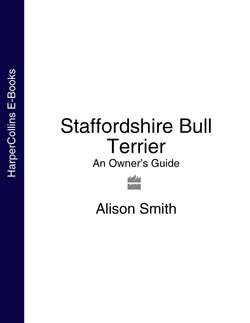Читать книгу Staffordshire Bull Terrier: An Owner’s Guide - Alison Smith - Страница 20
Bringing your puppy home
ОглавлениеThe day you collect your puppy will be very exciting. Make sure that at least two people (preferably adults) drive to pick him up. Puppies can get quite car sick at first and one of you will need to hold him and make sure that he does not become distressed. Some people advise taking a cardboard box full of towels for the journey. However, although this may be a sensible precaution, I have brought a puppy home inside my coat, where the tiny creature was quite happy to sleep during the 200-mile journey.
Puppy training pads
These are like giant nappies that you place wherever you wish the puppy to toilet. Start by positioning one just outside his crate and then gradually move it closer to the door. He will soon associate the pad with doing his business and will ‘follow’ it to his ultimate destination… outside. Pads can also prevent too much mess on the floor.
Your puppy will soon associate his crate with security and will enjoy going in there.
Wearing a collar
Get your puppy used to wearing a collar for the first time. Give him a couple of days to settle in first, and then introduce him to it gently. Most puppies don’t mind at all, but it will help with lead training if they grow accustomed to wearing a collar at the earliest possible age.
You may want to ask the breeder for a scrap of bedding which has the scent of the puppy’s mother on it, as it can be quite soothing for him if he can still smell something familiar amongst his new surroundings.
If your journey will be lengthy, remember to take a bottle of water and a small bowl with you in the car. If a toilet break becomes necessary, you can pull up somewhere well away from the traffic and stay close to your puppy until he has relieved himself.
Settling in at home
When you arrive home, introduce your puppy to your garden straight away. This will tell him that this is where he can relieve himself. Next stop should be his bed, which may be a crate, or a dog bed lined with old towels or blankets. Avoid fluffy bedding as your puppy will probably end up chewing most of it. Some people use sturdy cardboard boxes as first beds. These are OK, but you may find a huge pile of shredded cardboard and no bed the next morning.
Leave him to settle quietly and allow him to have a potter round and explore the house. Remember that this can be quite an overwhelming experience, and even though Staffords are generally very adaptable, your puppy has just left his mother and litter mates and has entered a whole new world, all in one day. If you have children, don’t let them overwhelm him. Explain to them that he needs peace and quiet while he settles in and when he feels more confident he will probably want to play. Young dogs need plenty of sleep and, much like their human counterparts, will probably eat, sleep and toilet for the first few weeks of their life.
Most puppies soon get used to wearing a collar and lead. Put them on your dog and let him trail them round the garden.
